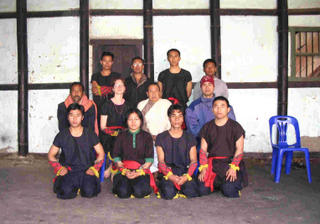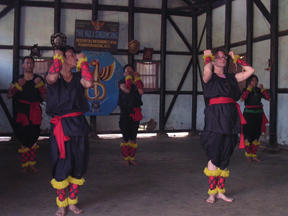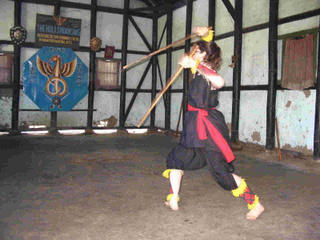By Heisnam Motcha
I was a stout young man of 23 when I joined Hula Sindamsang in 2001. Since then, I have been learning thang-ta, the Manipuri martial arts form, from Oja Devabratra. Many students joined and many have left but I am still continuing.
I was flummoxed when my Oja Devabratra told me that I had to accompany an American lady, who wanted to learn some movements of ‘thang-ta’. So two of my colleagues and I went to visit M.K. Binodini (or Emasi as she is known to is all) to discuss it. The contact had been made through her son Somi Roy who lives in New York. We were told that there were six Americans and they would arrive on November 18. The lady who wants to learn ‘thang-ta’ was Erin Mee. We were asked if any of us could accompany her every morning to our school, Hula Sindamsang. Somi was very conscious about the security of the persons who were arriving here. And I was chosen for the job. Then he asked me if I would be available on the evening of 18th as Somi wanted to introduce me to Erin. I agreed.

On 18th I was at Emasi’s at the appointed hour. There were some other people who were going to perform some traditional music for the visitors. While I was waiting, I met someone I knew - Sudersan, whose brother is a friend of my cousin.
Finally, the wait was over. The visitors arrived, one gentleman and four ladies. I was introduced to them. The youngest of them, whom I thought to be a little over twenty-eight - my age -, was Erin Mee. I guessed she must be around 5 feet 9 inches tall as she was about my own height. She wore glasses. She was blonde and very fair complexioned. Her other companions too had the same complexion. This was the first time I had come into close contact with Westerners. I had known Americans only from movies and television so this encounter was different and real. I asked Erin about the duration of her stay and how she felt after reaching Imphal. From the very first meeting Erin, like all the others, seemed very friendly.
Erin's "boriba", a ceremony of initiation at the beginning of learning an art form, was then fixed for the evening of the 20th. This was to be done with a prayer offering to the God Pakhangba, a compulsory ritual for every martial arts student.
Around 2 o'clock on the afternoon of the 20th, I reached at Somi’s place. Erin was getting various articles ready for the ceremony. She was wearing a black T-shirt, black slacks and slippers. Sudersan was also ready with a video camera as, I was beginning to see, he was always going to be documenting. We three went together to Hula Sindamsang. As soon as we reached, Oja Khelchandra arrived. Oja is the honorific term we use to call our masters. Oja Khelchandra is an eminent scholar and the president of our institute and Oja Devabratra was its principal.
As a rule, the head of the school always conducts the "boriba" ceremony, and so it was with Erin’s "boriba" as well. On a raised citadel in front of an idol of Pakhangba, there were some swords, sticks, and charcoal burners. Two spears and two long sticks formed crosses on either side of the citadel. There were two shields in front. The offerings for the "boriba" included a bunch of bananas, some oranges and a few gifts for the Oja.
A small area in front of the citadel was wiped clean. I put Erin’s gifts there. Then I lit three candles and three incense sticks. After I was finished making the arrangement, Oja Khelchandra recited a hymn to evoke the Inner Spirit to guide us in the process of learning. Erin and I knelt down. I was there beside her so as to help her follow the rules of the ritual.
To purify us, we were sprinkled with holy water with the aid of a sprig of leaves from the Tairel, a tree we hold sacred. After the prayer was over, Oja Khelchandra sat on a "mora", a stool of woven cane, and Erin kowtowed to him, presenting her gifts that included a white shawl and a pen. Oja blessed her, stroking her head.
Then Oja Khelchandra showed her a movement using a "cheibee", a leather-covered stick in the form of a sword. This particular movement, using the wrists, is the basic form of thang-ta. It is difficult for everyone. But to my surprise, Erin could repeat the performance in just a few seconds. It was not just I, but also others who were present, who was surprised at her skilful maneuvering of the sticks. Her performance gave me the impression that she was not only attentive but also had the aptitude for learning this oriental martial art form. If she continued learning, I felt she would surpass the students who had joined the institute even before she did. This particular impression will be an everlasting one to me as long as I live.
After Oja Khelchandra had left, Erin continued to practice for a while. Then we went inside the house to meet Oja Devabratra, as he had been bed-ridden for more than a month. From their conversation I learnt that Erin, being a theater personality, thought she would incorporate thang-ta properly in her work by learning it herself.
It was almost dark when we left Hula Sindamsang. I told Emasi and Somi about Erin’s performance. They were delighted to hear the news. I told Erin that I would come pick her up at 6:15 a.m. the next day and left.

But I kept thinking about what had happened that day; the way Erin had performed. I just couldn't get over the fact that a lady from a far-off place had just executed an art form supposedly reserved for men only. Of course we do have girl students too. Our institute had produced many female students and we currently had only one left, a girl named is Chitralekha. She had received a scholarship from the Government of India. But Erin’s case was different. Her habits and her way of life were totally different from ours, and yet, she could do it.
The class at Hula starts at 6:30 in the morning. So at 6:15 I reached Emasi’s place where Erin was staying with Zette Emmons, an American colleague of hers.. She was already ready. I rode my bicycle and Erin rode pillion. At the institute she continued with the lesson from the day before as she needed to perfect it. We also taught her some warm-up exercises developed in our institute. This was a unique form of exercise practiced by no other institution. At first she had some difficulty but later she seemed to cope well enough. At Hula we have a percept that anyone, boy or girl, who comes to learn this art form must comply with our method of teaching. We want every student to achieve perfection in this art. If someone is neglectful or just cannot stick to our rules, he just distances himself from the scene. This, I think, Erin recognized well, as she stated in her television interview later.

When we talked about our personal lives she spoke about her four-year- old daughter, her mother and her theater work. It was apparent that these things were a core part of her life. I also told her about my parents: about how my father became engaged in theater and how my mother also worked in theater. We also talked about the 9/11 tragedy in which the World Trade Center collapsed. I had seen that on television but hearing about it from the mouth of a New Yorker was very touching.
It was clear Erin was very much dedicated to her work and that she had left her child and mother to come to a distant land that most of her people had not heard about. This had an important impact to us all, especially about their women. I had gotten first-hand information about the freedom women have in her country. I had learned something about the freedom of women or feminism from novels by Sidney Sheldon and Jackie Collins. To this I had added information from television, magazines and movies.
One day our American friends gave a dinner party at Emasi’s residence. I was invited too. They called it Thanksgiving Dinner. They informed us that Thanksgiving is a major festival in the U.S., and that it was based on a story involving American Indians. They also said that it was a national holiday in U.S that people from all different walks of life celebrate, regardless of caste or creed. They said they no longer have holidays based on religion. Their practice stayed in my mind and I thought that if our government were to follow this too, communalism could be abolished from our society.
Our American friends offered us cranberry sauce and apple juice that they brought all the way from the U.S. Their attitudes gave me a sudden liking for all Americans. They made turkey for us, Western style, something I think nobody here had ever tasted before, though they may have known of it. While we ate, Erin conveyed her desire to send some more students from her school to learn thang-ta and drama in Manipur. I liked the idea too but then she said she didn't think she could get by Somi's security restrictions. She said Somi wouldn't even let her go alone to answer a call of nature!
I think she had good reason to think so because we simply cannot provide security and assist people for as long as a month. But we thought perhaps there might be some other arrangement that might satisfy both sides.
It was now getting a little late and I left early because I had to come back in the morning again.
On the last day at Hula, Erin wore our traditional attire for thang-ta. It consists of a "khudei", a loin cloth; a shirt-resembling the modern T-shirt; wrist guards called "khudang yai"; and shin-guards that we call "khubom yai". The color of attire was mainly black. Together we showed a performance to the spectators that included Oja Devabratra, Emasi, Zette, Somi and some others. Erin impressed everybody as she could follow the movements easily.
It was time for her to say goodbye to Hula. Oja Devabratra gave Erin four cane sticks as a token of memory and so that she could continue practising after she returned to the U.S. She kowtowed to Oja when she received the sticks.
It was November 27; a Saturday morning. Erin was busy packing. I went up to her and gave a shawl and a pen-stand as a gift. I also received a present in return. A friend of mine had brought some people from the local cable TV network to interview her. In that interview, she thanked all the people who helped her during the trip. She gave her warmest regards to all the Ojas of Hula Sindamsang and the students as well who gave her so much cooperation. She also expressed her desire to come back again.
Then came the time to say goodbye. We exchanged addresses and emails. My heart felt so heavy that I could not hide the feelings. I could not hide my eyes from the others present there. I rushed away from the crowd to hide my tear-soaked eyes. The memory of those days, with our American friends in this remote corner of the world will stay with me forever.
No comments:
Post a Comment